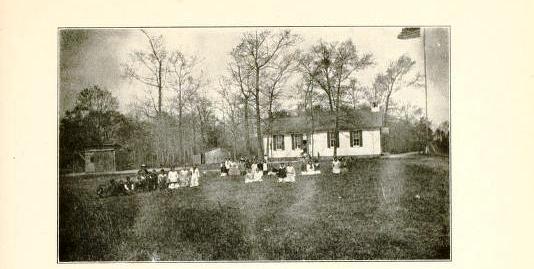The History of Caroline County, Maryland, From Its Beginning
Moore's

Mr. Moore, seeing the need of educational facilities for his neighborhood succeeded with the help of others in getting a school house built in 1857 or 8. It was erected on land given by Betsy Baynard.
The first teacher in this building was David Moore, a son of Thomas Moore. Since he was the first teacher and his people were so influential in obtaining the school, it has been called Moore's School. Robert Baggs, a northern man, was also among the first teachers.
About twenty-seven years ago some of the leading people of the district, among who was David Greenlee, were in favor of moving the schoolhouse to what seemed to them a more central location. David Greenlee had a road put through from the Greensboro-Hollandsville road to the Moore Mill Lane, as the road which the school was then on, was called. The building was finally
moved to a central location on this new road and placed on land given by William Hutson. Here it stood without any change until 1912, when it could no longer accommodate the large crowd of children attending, when a large room was built in front of the old one.
Before Moore's school was built it is said an old log schoolhouse stood on the Zimmerman farm near Betsy Baynard's land. There was also once a log schoolhouse, near what is now called "The Cool Spring," between the lands of Wilmer Draper and Thomas Bilbrough.
Betsy Baynard was a large land owner and slave holder. Her old home was about a half mile northwest from our school along the east side of the Choptank River.
Some stories: Miss Baynard was good to her slaves. After the Civil War her slaves were free, but many of them came back, finding they could not make a living. One poor ignorant woman when told she was free gathered up her husking pegs and other belongings, strung them about her body and started off in high spirits. After many days she came stumbling back, ragged and nearly starved to death.
Betsy had two sorrel horses which her servants had trained. When they wanted to ride these horses, they would hit them on the knee and say "Get down" and these horses would get down on their knees and stay there until the rider was on their back.
Betsy Baynard's slaves had their gala times. One man relates how they sometimes had a "husking bee" in the evening followed by a big dinner, music, dancing, games, and wine.
One of Betsy Baynard's slaves, Marie Hawkins, was about fifty years old when the Civil War ended. Miss Baynard did not want Marie to leave her, so gave Marie a lot close by the Choptank River and built a log house thereon.
The people of this community, (Moore's district), feeling the need of a suitable house of worship set to work to erect one in 1873.
Betsy Baynard gave the land for the church site, which is just across the road from her home, and also lumber for the building. This was about five years before her death.
Rev. John Irvin, a Methodist for whom the chapel was named, was the first preacher. David Greenlee was the class leader.
Prior to the building of this church, services were held in the old schoolhouse.
John Irvin also preached at Cedar Grove Chapel and the Kent County, Delaware, Almshouse. His remains lie in the Cedar Grove graveyard. --- Contributed.